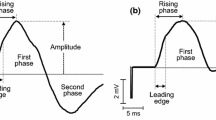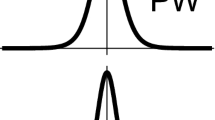Abstract
The power spectra of the extracellular potentials (EPs) generated under activation of an infinite, homogeneous excitable fibre immersed into an infinite, resistive, isotropic and homogeneous volume conductor are theoretically analysed. The changes in the power spectrum related to the changes in the propagation velocity v, amplitudes Vm and duration Tin of the intracellular action potential (IAP) are analytically determined. It is found that in the ultra-low-frequency region the EP spectral power follows the course of alteration in the square of the modified Bessel function of the second kind and order zero multiplied by the fourth power of the frequency, and the Tin can be assessed by the deviation of the EP power spectrum from this function. It is shown why the sensitivity of the spectral characteristics depends substantially on the radial distance y0 from the activated fibre to the point of observation; why the total spectral amplitude depends directly on the IAP wavelength but the total spectral power depends on the IAP wavelength as well as on its duration and propagation velocity; and why the EPs are not proportional to the IAP second spatial derivative even in close proximity to the fibre.
Similar content being viewed by others
References
Agarwal, G. C. andGottlieb, G. L. (1975) An analysis of the electromyogram by Fourier, simulation and experimental techniques.IEEE Trans.,BME-22, 225–229.
de Luca, C. J. (1984) Myoelectrical manifestations of localized muscular fatigue in humans.CRC Crit. Rev. Biomed. Eng.,11, 251–279.
Dimitrov, G. V. andDimitrova, N. A. (1974) Influence of the asymmetry in the distribution of the depolarized level on the extracellular potential field generated by an excitable fibre.Electromyogr. Clin. Neurophysiol.,14, 225–275.
Dimitrov, G. V. (1987) Changes in the extracellular potentials produced by unmyelinated nerve fibre resulting, from alterations in the propagation velocity or the duration of the action potential. —Ibid.,27, 243–249.
Dimitrov, G. V., Lateva, Z. C. andDimitrova, N. A. (1988) Effects of changes in asymmetry, duration and propagation velocity of the intracellular potential on the power spectrum of extracellular potentials produced by an excitable fibre. —Ibid.,28, 93–100.
Dimitrov, G. V., Dimitrova, N. A. andLateva, Z. C. (1989) Integral characteristics of extracellular single fibre action potentials. —Ibid.,29, 195–201.
Dimitrova, N. A. (1973) Influence of the length of the depolarized zone on the extracellular potential field of a single unmyelinated nerve fibre. —Ibid.,13, 547–558.
Fleisher, S. M. (1984) Comparative analysis of modelled extracellular potentials.Med. & Biol. Eng. & Comput. 22, 440–447.
Fleisher, S. M., Studer, M. andMoschytz, G. S. (1984) Mathematical model of the single-fibre action potential. —Ibid.,22, 433–439.
Gradstein, I. S. andRijic, I. M. (1962)Tables of integrals, sums, series and products. Fizmatgiz (in Russian).
Hermens, H. J., Boon, K. L. andZilvold, G. (1984) The clinical use of surface EMG.Electromyogr. Clin. Neurophysiol.,24, 243–265.
Korn, G. A. andKorn, T. M. (1968)Mathematical handbook for scientists and engineers. McGraw-Hill, New York.
Krakau, C. E. T. (1957) A note on the Fourier transform of Lorente de Nó's potential function of the external field of a nerve in a volume conductor.Kungl. Fysiogr. Sällsk. i Lund Förhandl.,27, 177–183.
Lateva, Z. C. (1988) Dependence of quantitative parameters of the extracellular potential power spectrum on propagation velocity, duration and asymmetry of action potentials.Electromyogr. Clin. Neurophysiol.,28, 191–203.
Lindström, L. (1970) On the frequency spectrum of EMG signals. Technical Report 7:70, Research Lab. Medical Electronics, Chalmers University of Technology, Göteborg, Sweden.
Lindström, L. (1973) A model describing the power spectrum of myoelectric signals. Part I: Single fiber signal. Technical report 5:73. Research Lab. Medical Electronics, Chalmers University of Technology, Göteborg, Sweden.
Lindström, L. andMagnusson, R. (1977) Interpretation of myoelectric power spectra: a model and its application,Proc. IEEE,65, 653–662.
Lindström, L. andPetersen, I. (1981) Power spectra of myoelectric signals: motor unit activity and muscle fatigue. InClinical Neurophysiology (v. Neurology 1). Butterworths, 66–87.
Lindström, L. andPetersen, I. (1983) Power spectrum analysis of EMG signals and its applications. InProgress in clinical neurophysiology, Vol. 10: Computer-aided electromyography.Desmedt, J. E. (Ed.),Karger, Basel, 1–51.
Lorente de Nó, R. (1947) A study of nerve physiology. Studies from the Rockefeller Institute for Medical Research, New York,132, 384–477.
Pattle, R. E. (1971) The external action potential of a nerve or muscle fibre in an extended medium.Phys. in Med. & Biol.,16, 673–685.
Plonsey, R. (1969)Bioelectric phenomena. McGraw-Hill, New York.
Plonsey, R. (1974) The active fibre in a volume conductor.IEEE Trans.,BME-21, 371–381.
Plonsey, R. (1977) Action potential sources and their volume conductor fields.Proc. IEEE,65, 601–611.
Rosenfalck, P. (1969) Intra- and extracellular potential fields of active nerve and muscle fibres.Acta Physiol. Scand., Suppl.,321, 1–168.
Sato, H. (1982) Functional characteristics of human skeletal muscle revealed by spectral analysis of the surface electromyogram.Electromyogr. Clin. Neurophysiol.,22, 459–516.
Spach, M. S., Barr, R. C., Serwer, G. S., Kootsey, J. M. andJohnson, E. A. (1972) Extracellular potentials related to intracellular action potentials in the dog Purkinje system.Circ. Res.,30, 505–519.
Stulen, F. B. andde Luca, C. J. (1981) Frequency parameters of the myoelectric signal as a measure of muscle conduction velocity.IEEE Trans.,BME-28, 515–523.
Wilson, F. N., MacLeod, A. G. andBarker, P. S. (1933) The distribution of the action currents produced by heart muscle and other excitable tissues immersed in extensive conducting media.J. Gen. Physiol.,16, 423–456.
Author information
Authors and Affiliations
Rights and permissions
About this article
Cite this article
Dimitrov, G.V., Lateva, Z.C. & Dimitrova, N.A. Power spectra of extracellular potentials generated by an infinite, homogeneous excitable fibre. Med. Biol. Eng. Comput. 28, 24–30 (1990). https://doi.org/10.1007/BF02441673
Received:
Accepted:
Issue Date:
DOI: https://doi.org/10.1007/BF02441673




